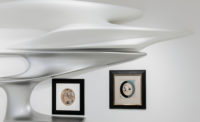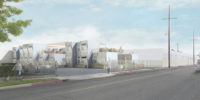Six Finalist Designs Unveiled for Guggenheim Helsinki






















Guggenheim Helsinki Now: Six Finalist Designs Unveiled, on view at Kunsthalle Helsinki this spring, marks the second phase of the embattled Guggenheim Helsinki design competition. The exhibition, following the announcement this December that a whopping 1,715 design submissions had been whittled down to six, highlights fully-developed proposals by the firms AGPS Architecture Ltd., Asif Khan Ltd., Fake Industries Architectural Agonism, Haas Cook Zemmrich STUDIO2050, Moreau Kusunoki Architect, and SMAR Architecture Studio. The show presents the resulting renderings and models, unmarked to preserve the anonymity mandated by Finnish law, to the 11-person jury that includes architects Jeanne Gang and Mark Wigley, and Helsinki City Planning director Mikko Aho.
As the jurors deliberate on each proposal’s merits, the exhibition takes on the dual role of addressing the Finnish public’s skepticism of a Guggenheim franchise arriving on their waterfront.
“Because this is a very visible project in Helsinki, anyone you talk to on the street has heard of it, and most likely has an opinion,” says curator Troy Conrad Therrien, head of Architecture and Digital Initiatives at the Guggenheim.
The exhibition opens, in fact, just days after the launch of counter-proposals commissioned by the Guggenheim detractors of Next Helsinki, a group of architects led by critic Michael Sorkin who oppose what they’ve called “the cultural equivalent of Starbucks.”
“My job is to appeal to a broader public—children and grandparents,” says Therrien, who, as part of the Guggenheim’s charm offensive, filled the exhibition with interactive components. He’s humanized the proposals quite literally, assessing their personality traits and commissioning eBay chief scientist Hugo Liu to develop a custom matchmaking app. After answering a series of questions—favorite time of day, predictions on how the world will end, preference between male or female architecture—visitors are matched with the Guggenheim of their dreams through this architectural version of eHarmony.
Ultra-contemporary methods of data dissemination through social media—a key component of this competition since the museum’s unprecedented online publication of every submission—continues as 500 of the original submissions are released as open-source architecture for anyone to use commercially with proper attribution to the architects.
"This is the largest architectural competition in history," says Therrien. "The exhibition celebrates the entire process." In the galleries, video interviews with the six firms play, data is plotted in a lightbox to resemble stars in a galaxy, key renderings are shown as panoramas up to 13 feet high, photographs offer an illustrated timeline of the site, 15 honorable mentions are unveiled for the first time, and all 1,200 firms that elected to be identified are acknowledged by name.
At the entrance of the exhibition, six architectural models suspended from the ceiling dangle over a 500th-scale wooden replica of the city, anticipating that one will eventually land safely in Helsinki’s South Harbor. The winner will be announced June 23, but for now, they’re still up in the air.
“Guggenheim Helsinki Now: Six Finalist Designs Unveiled,” is on view at Kunsthalle Helsinki from April 25 through May 15.













